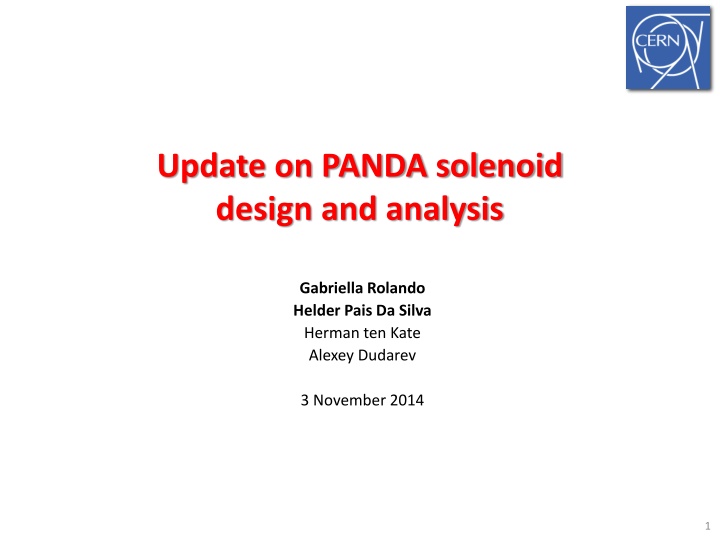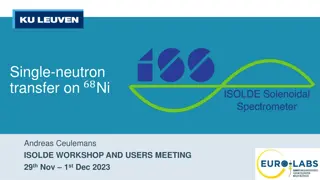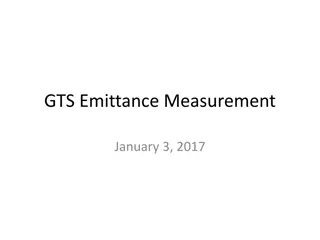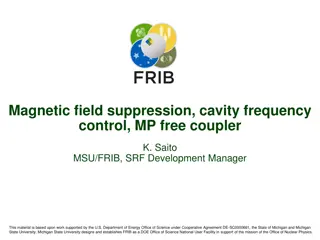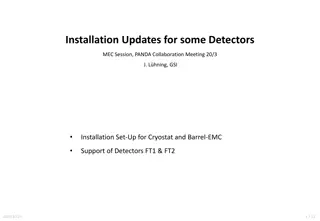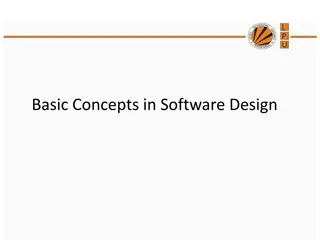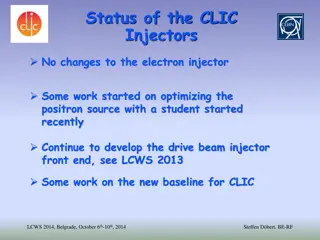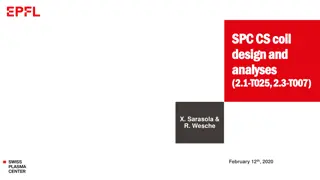Update on PANDA solenoid design and analysis
This update discusses the design and analysis of the PANDA solenoid by Gabriella Rolando, Helder Pais Da Silva, Herman ten Kate, and Alexey Dudarev. The content focuses on advancements made in the solenoid's engineering, with insights into the latest developments and optimizations. It provides a comprehensive overview of the ongoing work on the PANDA solenoid project, highlighting key findings and potential future directions.
Download Presentation

Please find below an Image/Link to download the presentation.
The content on the website is provided AS IS for your information and personal use only. It may not be sold, licensed, or shared on other websites without obtaining consent from the author.If you encounter any issues during the download, it is possible that the publisher has removed the file from their server.
You are allowed to download the files provided on this website for personal or commercial use, subject to the condition that they are used lawfully. All files are the property of their respective owners.
The content on the website is provided AS IS for your information and personal use only. It may not be sold, licensed, or shared on other websites without obtaining consent from the author.
E N D
Presentation Transcript
Update on PANDA solenoid design and analysis Gabriella Rolando Helder Pais Da Silva Herman ten Kate Alexey Dudarev 3 November 2014 1
Outline Part I Conductor procurement status New conductor layout New coil layout Field quality & pressure on the coils Eddy current loss in the coil windings Eddy current loss in the casing Temperature distribution in the cold mass Shear stress at the coil-casing interface Part II Coil cross-section Coil winding Coil and support cylinder analytic stress assessment Support cylinder dimensions Pro s & con s of the new coil design Conclusion 2
Part I Conductor procurement status New conductor layout New coil layout Field quality & pressure on the coils Eddy current loss in the coil windings Eddy current loss in the casing Temperature distribution in the cold mass Shear stress at the coil-casing interface 3
Conductor procurement status Furukawa s price offer of August 29 of 191 $/m; still 36% higher than expected. Furukawa reported the unit length (max 3200 m ) as main price driver. New quotation requested for 4 x 1600 m and 1 x 1500 m unit lengths on September 17. On October 1, Furukawa replied that price will decrease further towards the expected target (120-140 $/m), although it would probably not reach the cost of the DS1 conductor (Mu2e experiment) due to the larger cross-section area. However, a number was not given. A budgetary offer has been requested on October 21; for the 6-around-1 conductor. According to Furukawa price will likely not vary due to R&D required for Al-stabilized 6-around-1 conductor. On October 31 , Furukawa replied and stated no significant cost reduction expected on 6-a-1 cable (no experience, R&D required). We will now propose the new conductor size with an 8 strands Rutherford cable instead. For starting of real tender, still waiting for confirmation of tendering partner and budget. 4
New conductor layout Driving factors in conductor design: Minimize the risk of quenches temperature margin T 2.4 K. Ease the coil winding low height-to-width ratio conductor Parameter TDR Modified TDR 6-around-1 New Rutherford - Layout N. of strands 20 26 6 + 1 core* 8 Strand diameter [mm] 0.8 1.5 1.4 Cu : nonCu ratio 1.5 1.2 1.0 1.0 Cable dimensions [mm] 8 x 1.15 9.7 x 1.5 4.5 2.6 x 5.3 Conductor bare dimensions [mm] 24.6 x 3.4 7.9 x 10.9 T [K] 1.8 2.4 2.3 2.4 * Core material options: Cu, Al, SS 5
New coil layout Parameter TDR Modified TDR 6-around-1 Rutherford Iop [kA] Inner radius [mm] Outer radius [mm] 5 4.98 1050.0 1050.1 1100.0 1099.9 Layers / coil 2 6 -1025.0 < z < -143.4 [mm] -1024.9 < z < -143.5 [mm] Up-stream coil Turns = 464 Turns = 468 157.4 < z < 552.6 [mm] 162.9 < z < 547.1 [mm] Center coil Turns = 208 Turns = 204 Down-stream coil 853.4 < z < 1735.0 [mm] 853.5 < z < 1734.9 [mm] Turns = 464 Turns = 468 6
Field quality & pressure in the coils Bpeak [T] - | |max [%] < 2.0 Intmax [mm] < 2.00 Comparison of field quality in tracker region for the different conductor designs. Design Criterion: Modified TDR 2.9 1.69 2.05 6 layers layout result in better field quality and lower peak field. 6-around-1 Rutherford 2.71 2.75 1.67 1.60 1.75 1.76 New design Maximum axial and radial pressure on a sub-coil. TDR values are confirmed. Max Faxial [MN] 4.0 3.9 3.9 Max Paxial [MPa] 11.8 11.6 11.6 Max Fradial [MN] 17.2 17.2 17.2 Max Pradial [MPa] 2.9 2.9 2.9 Design Modified TDR 6-around-1 Rutherford New design 7
Eddy current loss in the coil windings Eddy currents in a rectangular thin plate Conservative estimate: B = Bpeak on all the turns No magneto-resistance Parameter TDR design New design Bpeak [T] 3 3 Al @ 4.5 K [ m] RRR = 1000 The low height-to-width ratio conductor features practically zero loss for every ramp time. Eddy current loss with TDR design add an extra 30% on top of casing loss. What is the required current ramp time? 2.480 e-11 2.480 e-11 tramp [s] 1500 1500 Peddy [W] 5.2 0.6 tramp [s] 2000 2000 Peddy [W] 2.9 0.3 8
Eddy current loss in the casing ?2 ? = ??????? Parameter TDR design New design ? = ? ?? I [kA] 5 4.98 ?? Al-5083 @ 4.5 K [ m] 3.03e-8 3.03e-8 Eddy currents in the casing produce the contribution during ramp & slow dump. main loss tramp [s] 1500 1500 Peddy [W] 17.4 17.2 Eddy current power loss is reduced of ~ 2 when ramp time increases from 1500 s -> 2000 s. tramp [s] 2000 2000 Peddy [W] 9.78 9.7 9
Temperature distribution in the cold mass Cooling channels Steady-state thermal model of the cold mass during ramp up & slow dump casing coil coil coil Pure Al strip Features 6 cooling channels 1.5 mm thick high purity Al thermal contact with the cooling channels and surrounding the 3 sub-coil modules strips in Insulation 10
Temperature distribution in the cold mass Loads Eddy current loss in the conductor Eddy current loss in the casing Radiation heat flux 0.12 W/m2 (based on ATLAS CS data) Design Tramp [s] Tpeak [K] TDR 1500 4.57 The thin high purity Al strip in thermal contact with the cooling ribs ensures minimalincrease of the cold mass temperature during current ramp up and slow dump of the magnet. 4.54 2000 TDR New 1500 4.56 New 2000 4.54 11
Shear stress at the coil-casing interface Magneto-structural model of the cold mass at operating current Peak shear stress at coil-casing interface [MPa] casing Design coil coil coil With spacers 3 casing Without spacers 10 coil coil coil Maximum epoxy shear stress 30 MPa. Maximum shear stress at coil-casing interface below epoxy limit even without spacers between the coils. TDR values are confirmed. Shear stress distribution in the cold mass 12
Part II Coil cross-section Coil winding Analytic stress assessment Support cylinder dimensions 13
Coil cross-section 1/2 Update: Two flanges and one support cylinder per sub coil Layer of G10 to compensate for winding and cable tolerances Sliding interface between coil and flanges 14
Coil cross-section 2/2 Update: Two flanges and one support cylinder per sub coil Layer of G10 to compensate for winding and cable tolerances Sliding interface between coil and flanges High purity aluminum strips to improve cooling 15
Coil winding A vertical winding set-up is preferable. A simple collapsible mandrel will be designed for our purpose. One of the coil flanges will be connected initially to the winding mandrel. The cable winding is transposed , using joggles in every turn. 16
Analytic stress assessment 1/3 Bare coil under radial magnetic force Parameter Value Hoop stress ??[MPa] 62 Hoop stress ??[MPa] 59 Without external support the coil windings will yield. Radial stress ?? [MPa] -2.9 Radial stress ??[MPa] 0 Max. von Mises stress [MPa] 64 Safety factor 0.63 17
Analytic stress assessment 2/3 40 mm support cylinder with no contact pressure at cold Parameter Coil Casing Support Cylinder Contact pressure [MPa] 1.240 Coil Hoop Stress ??[MPa] 34 33 Contact Pressure Hoop Stress ?? [MPa] 35 33 Radial Stress ?? [MPa] -2.9 1.2 Radial Stress ??[MPa] -1.2 0 Max. von Mises stress [MPa] 36 35 A 40 mm thick support cylinder allows operating the coil close to yielding of the conductor. Safety factor 1.1 4.1 ???[mm] 0.47 0.48 ???[mm] 0.48 0.47 18
Analytic stress assessment 3/3 40 mm support cylinder with 0.7 mm overlap Support Cylinder Coil Contact Pressure Energized Magnet Magnet Magnet Energized Energized Warm Magnet Warm Magnet Warm Magnet Cold Magnet Cold Magnet Cold Magnet Support Cylinder Cylinder Cylinder Support Support Support Cylinder Cylinder Cylinder Support Support Support Cylinder Cylinder Cylinder Support Support Coil Coil Coil Coil Coil Coil Coil Coil Coil Pre-stress required to increase the safety factor to 1.5 is small. The thicknesscould be reduced, but 40 mm is ideal for assembly purposes. Required ?T between bodies for assembly 90 K. Overlap [mm] Overlap [mm] Overlap [mm] 0.7 0.7 0.7 0.5 0.5 0.5 Contact Pressure [MPa] Max. von Contact Pressure [MPa] Max. von Mises stress [MPa] [MPa] [MPa] Contact Pressure [MPa] Max. von Mises stress Mises stress 0.90 0.90 0.90 0.73 0.73 1.97 20 20 20 26 26 26 16 16 21 21 20 56 Safety factor Safety factor Safety factor 1.5 1.5 1.5 5.6 5.6 5.6 2.4 2.4 7.0 7.0 2.0 2.6 19
Support cylinder dimensions Cold dimensions of the coil and cylinder depend on: Material properties Initial dimensions of the components Interference length Notes: The warm dimensions and interference of the components will be adjusted to compensate for non-conformities. A 3D FEM stress analysis is needed to assess behavior near the coil ends. A dummy coil will be first produced to test the coil winding and assembly procedure. Coil Cylinder ?? [mm] ?? [mm] ?? [mm] ?? [mm] 1134.7 Energized magnet 1045.1 1094.9 1094.9 Cold magnet 1044.6 1094.4 1094.4 1134.2 Cold separated components 1044.8 1094.7 1094.2 1134.0 Warm 1049.3 1099.4 1098.7 1138.7 Winding radius (10 MPa tension) - 1049.8 1099.9 - 20
Pros & cons of the new coil design Pro s Easier co-extrusion process. Easier winding and cheaper winding tooling. Lower loss in the conductor during ramp up and slow dump. Improved field quality on tracker region. Lower peak field on the conductor. Con s Potentially higher temperature gradient on the coil due to the higher number of layers but The issue is not relevant when the sub-coil modules are surrounded by thin high purity Al strips in thermal contact with the cooling ribs. 21
Conclusion The 6 layers winding solution is recommended as it allows easier manufacturing and cost reduction. The presence of a high thermal gradient over the winding during current ramp up/down is effectively avoided by surrounding the sub-coil modules with a thin high purity Al strip in thermal contact with the cooling ribs. The TDR value for the maximum axial and radial pressure on a sub-coil are confirmed. The TDR value for the maximum shear stress at the coil-casing interface is confirmed. The eddy current loss during ramp up and slow dump are assessed and in agreement with the TDR value for tramp = 2000 s and a coil former thickness of 30 mm. A budgetary offer for the 6-around-1 conductor has been requested to Furukawa. Price is comparable to 26 strands Rutherford. 22
